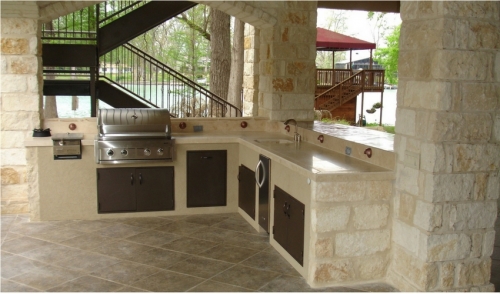
Build a Brick Barbecue
The benefits of building a brick barbecue are multifold. A brick barbecue can accent your patio beautifully, and the brick design blends well with any garden setting. Not only does it look great, but it can give any ordinary food a delicious flavor. Once you build one, you’ll wonder how you ever got through the summers without one.
Brick barbecues are usually made with a lot more grilling space than your standard sized grill, so they are great for outdoor parties. Also, brick barbecues are very durable and weather resistant.
You can build either a brick barbecue with or without mortar, each of which has different advantages. Using mortar ensures durability, but your barbecue is permanent. Not using mortar is not quite as durable and stable, but it is easy to take down and quickly rebuild if you decide to move.
Building a brick barbecue is an easy job that will cost you less than installing a new gas grill and lasts much longer. With the right tools, materials and a little skill, you can have a barbecue that will be the envy of all your neighbors.
Build a Barbecue with Mortar
Tools and Materials you need:
- Barbecue grills
- Firegrates
- Ashtrays
- Chalk line
- Pointed trowel
- Dry-mix brick mortar
- SW-grade bricks
- Builder’s square
- Level
- Z-shaped metal ties
- 7-inch x 3/8 inch rebar (24 pieces)
- Brackets and cutting board (optional)
- Fluted masonry nails (optional)
(1) Buy the Materials
Purchase the barbecue grills, fire grates and ashtrays at your hardware store before you begin building. These items will determine how large the barbecue will be, so you must have them ahead of time. Decide how many bricks you need once you determine the size of the grill. Your average barbecue is 13 courses (or rows) high. If you want a cutting board attached to the barbecue you can purchase the board, brackets and other necessary materials at your hardware store.
(2) Pick a Spot For the Barbecue
You will need a level concrete or brick spot for your barbecue. If you do not have a concrete or brick patio, you will need to lay a small concrete base for your barbecue. You may also want to consider which way the wind usually blows, and position the barbecue so that the smoke blows away from the cook and the dining area.
(3) Size Your Barbecue
Outline how large your barbecue will be with a chalk line on the base concrete slab. Without mortar, lay two courses (or layers) of brick to help determine the size of your barbecue. Remember to leave 1/2 inch between each brick for mortar joints. Follow the brick laying pattern diagram for the first course.
(4) Lay the First Course
Remove the bricks and use a pointed trowel to apply mortar to the concrete base, but do not go beyond the chalk lines. Lay the first layer of bricks following the diagram for the first course. Apply mortar to the sides of each brick before you lay it and butt the bricks up against each other.
(5) Lay the Rest of the Courses
The rest of the courses alternate in pattern. The even numbered courses follow one pattern while the odd numbered courses follow another pattern. See the diagram in Figure 1 for the patterns. Alternate the patterns until you have 13 courses. Use a level to make sure that each course is even, and use a builder’s square to ensure that the corners come to a perfect 90 degree angle. On each odd numbered course (1, 3, 5…), set z-shaped metal ties in the mortar and distribute them evenly. Place the z-shaped ties in different spots on each course.
(6) Set the Rebars in the Mortar Each course will be 3 wythes wide on both sides. A wythe is a vertical tier of bricks, each single wythe being 1 brick wide. We recommend that the barbecue be 3 bricks wide on each side. Before you place the inner wythe of the eighth course, set 7-inch rebars in the bed joints with 4 inches projecting from the bricks. Set four rebars on each side of the barbecue to hold the grate. Use the same process to install rebars on the ninth and twelfth courses. This allows room for 2 grilling racks. In all,you will be using 24 pieces of rebar.
(7) Lay the Top Course
For the top course, the inner row is laid with its narrow side facing out as a stretcher, and the outer row is laid with its short side facing out as a header. (See Figure in Step 6.) Once the mortar is dry, you can attach a cutting board to the side of the barbecue with fluted masonry nails. Ask your hardware store to help you find the right ones.
Build a Storage Bin (Optional)
Tools and Materials you need:
- SW-grade bricks
- Dry-mix brick mortar
- Pointed trowel
- Level
- Wood (for door and frame)
- Galvanized nails
- Two 2-inch brass butt hinges
- Spring catch
- Drill
(1) Pour a Concrete Top For the Storage Bin
Follow the same directions for building a brick barbecue using mortar. You will attach the storage bin to either side of the barbecue. Use 2 x 4s to make a frame for the concrete slab that will cover the storage bin. The slab’s dimensions are 20 3/4 x 20 3/4 x 2 3/4 inches, so the frame should also fit those dimensions. Use a scrap piece of wood the same size as the door frame top, and set it in the front of the form to make a frame indention. Lay the frame over a level area covered with plastic and pour in the concrete, allowing it to dry completely.
(2) Cut the Frame
Cut the frame out of 1 x 2-inch pieces of wood, measuring each side of the frame to be 13 1/4 inches. Drive nails into the wood and through the mortar connecting the frame to the brick walls of the storage bin.
(3) Attach the Concrete Top
Once the frame is fastened to the mortar. Lay the concrete top over the storage bin so that the frame fits into the framed indention in the concrete slab. Lay brick with mortar over the concrete in the same pattern you used for the brick barbecue.
(4) Cut and Attach Storage Bin Door
The door should be constructed from 4 pieces of 1 x 4-inch wood and nails. Before attaching the door to the bin, nail 2 pieces of 1 x 2-inch wood to the frame as cross strips at the top and the bottom. (See Figure Above.) Each cross strip should be 11 1/4 inches long. Nail a 9-inch piece of 1 x 2-inch wood perpendicular to the cross strips on the left side between the two cross strips. This piece will serve as the hinge strip. Attach one 2-inch brass hinge to the hinge strip and one to the door and attach the door to the hinge strip. Install the spring catch and door pull to the door and frame following manufacturer’s instructions. Drill a hole in the door and attach a small brass handle.
Build a Brick Barbecue Without Mortar
Materials you need:
- SW-grade bricks
- Barbecue grills
- Fire grates
- Ashtray
(1) Find a Level Spot
Building a barbecue without mortar is an easy project. It is very important that the area you choose for the barbecue is completely level and stable, since there will be no mortar to hold the bricks together. For this type of barbecue, it is best to build over a concrete slab instead of a paved area.
(2) Lay the Bricks
The bricklaying process for a mortarless barbecue is much simpler than that of a brick barbecue with mortar. The bricks are laid in alternate pairs of headers and stretchers. Two bricks face one direction and the two next to those face in the opposite direction like a basket-weave pattern. The standard height for this barbecue is thirteen courses high.
(3) Set Grill Supports
The inner bricks of the fourth and seventh courses are slightly pushed out into the fire box to create ledges that support grills.

